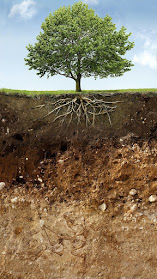Soil Profile
The vertical and
sequential arrangement of soil layers superimposed one above the other from the
top surface to the unaffected rock below is termed as soil profile. The
individual layers constituting the soil profile are called soil horizons.
For instance, if we cut a vertical section of soil at a particular place, we clearly see
different soil layers or horizons from top mature soil to the rock below.
These horizons are formed
through the differential downward movement of various materials such as organic
matter, clay particles etc. moreover soil horizons vary in properties like
colour, texture, structure, thickness, chemical composition, mineral content,
consistency and reaction.
In general soil profiles
tend to become thicker, deeper and more altered over time.
Soil profile can be as
little as 10cm thick in immature soils and as deep as several meters in
tropical areas.
Soil profile is
considered as one of the most important key factor for understanding the
process of soil development and is the basis for their classification.
Characteristic features of soil profile
- Upper most layer of the soil profile contains maximum amount of organic matter, living organisms and life activities.
- The quantity of minerals keeps on increasing from the top to the bottom in a profile.
- The amount of soil air goes on decreasing by increasing the depth.
- The amount of soil water is variable in different layers.
- Profiles of different types of soils differ in in physico-chemical and biological properties.
- The differences are
developed from the interaction of soil farming factors as parent material,
slope, weathering, native vegetation, climate etc.

Soil Horizons
Soil Horizons
According to German terminology the different layers or horizons of a soil profile were grouped under three headings, A, B, and C. But according to present terminology which is in general use the soil profile consists of five main horizons O, A, B, C, and R horizon. Depending upon further variations within these O1, O2, A1, A2, B1, B2, B3, C and D also form a part of the soil.
The ‘O’ horizons
These are the topmost
horizons of soil profile commonly known as organic horizons or carbonic
horizons consisting of dead and leaving organic matter. These horizons are
found in forested areas specially in temperate regions but absent in grassland
ecosystem. ‘O’ horizon consists of two sub-layers:
O1
region: This
is the uppermost region of the ‘O’ horizon consisting of freshly fallen leaves,
twigs branches, fruits, seeds, dead remains of plants and animals. Due the
presence of these undecomposed organic material this layer is also known as
litter layer. This layer is present in forest soils but absent in grassland
soils.
O2 region: The layer below the O1 or the second layer of the ‘O’ horizon is names as O2 region.In this region the decomposition of organic matter is just begin under the action of various microorganisms such as bacteria, fungi, slime molds, actinomycetes. metabolic process such as fermentation and humification occur in this layer that is why this region is also known as F (fermentation) or H (humified zone).
- The ‘A’ horizon
‘A’ horizon is often referred
to as topsoil and is considered as the mineral horizons which is formed by the
accumulation of organic matter and the products of decomposition. ‘A’ horizon
is also known as eluviation zone because there occurs a downward loss of
soluble salts, clay, iron or aluminum due to leaching and bleaching mechanism. ‘A’
horizon provide the best environment for the growth of plant roots,
microorganisms and other life. This horizon is further divided into two
sub-layers.
A1
region (‘A’ horizon): Typical dark colour is the characteristic
feature of this layer due to the presence of organic matter which mixes with
inorganic minerals formed as a result of weathering. This mixing phenomenon of
organic matter with the inorganic product of weathering is referred to as humus
which is dark brown or black in colour therefore this region is also known as
humic or melanized region. This region is quite dominant in grassland as
compared to forest soils.
A2 region or ‘E’ horizon: This layer is not present in all profiles. In comparison to A1 region this region is of light colour with less amount of organic matter. The organic matter and mineral elements are rapidly lost downward as a result of eluviation because of rapid eluviation this region is also known as E-horizon or eluvial zone or podsolic zone or zone of leaching.
- The ‘B’ horizon
These are the mineral
horizons lies just beneath the ‘A’ horizon the characteristic feature of this horizon
is process of illuviation that is accumulation of downward moving fine material
consisting of clay minerals, iron, silicates, aluminum, manganese, and humus.
Sesquioxide coating of mineral grains imparts an intense dark colour in this
horizon as compared to the zones above or below it.
The colour of this zone is dark and the texture is coarse due to accumulation of above mentioned inorganic minerals. Together ‘A’, ‘E’ and ‘B’ horizons are known as solum. The ‘B’ horizon is also known as zone of illuviation or illuvial zone. The ‘B’ horizon is also sub divided into B1, B2 and B3 layers.
- The ‘C’ horizon
This layer often referred to as sporolite or regolith or weathering rock and lies just beneath the ‘B’ horizon consisting of partly weathered parent material. It is devoid of organic matter.
- The ‘R’ horizon
This zone is characterized by the presence of un-weathered parent material or bed rock such as limestone, sandstone or granite. It is also known as ‘D’ horizon.
Fine notes
ReplyDeleteComprehensive
ReplyDelete